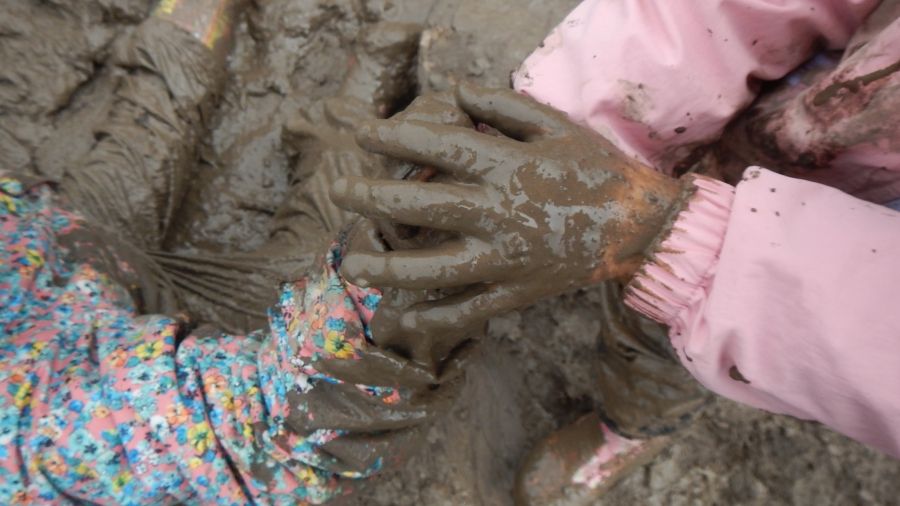
During spring while the earth is awakening, buds begin to swell and slowly open to reveal tiny leaves. The earth begins to soften and becomes saturated with frequent spring showers. The rain produces puddles that line our trails and flow into one another, traveling down the ravine to Lake Michigan. In our play spaces at the Schlitz Audubon Nature Center, the water swells our mud pits, which the children use to for soups, cakes, and to fill trenches in the sand. We say that there are three seasons in nature preschool in Wisconsin: Fall, Winter, and MUD.
Diving In
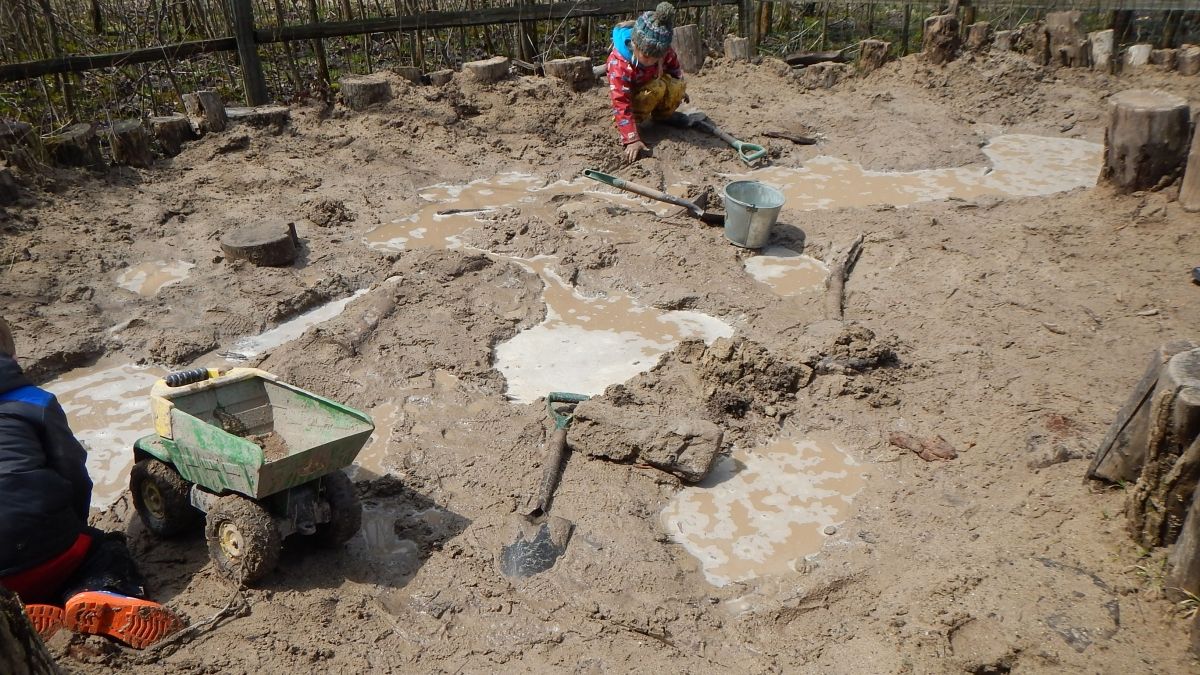
Schlitz Audubon Nature Center
It doesn’t take long for children to embrace the possibilities of mud. One spring afternoon, after a night of strong winds that brought a downpour of water, our mud pit was full. As some children raced around the playspace in the new growth of plants playing hide and seek, another smaller group walked to the edge of the mud pit and began to sense the possibilities.
The mud invited them in. The children walked across from one side to the other feeling the mud engulf their boots with every step, sucking their boots into the earth like quick sand. Whenever we find what we call “boot-sucking mud,” we teach the children to point their toes to the sky as they step so they don’t lose their boots to the mud. We often hear the children teaching others to do the same as they walk through.
Another child sat on the edge of the mud pit dipping her hands into the mud, covering them with squishy, squelchy mud. “This mud is cold today,” she said as she continued to dip them in and out of the mud, providing a rich sensory activity that was feeding her brain. She invited another child in, and there they sat, dipping their hands in and out of the mud, laughing big belly laughs as they watched their hands go from clean to dripping with mud.
Into the Trenches
In the play space, we have a shed that holds tools for the children to play and explore with. It has shovels, wheelbarrows, buckets, paint brushes, and dump trucks to name a few of our treasures.
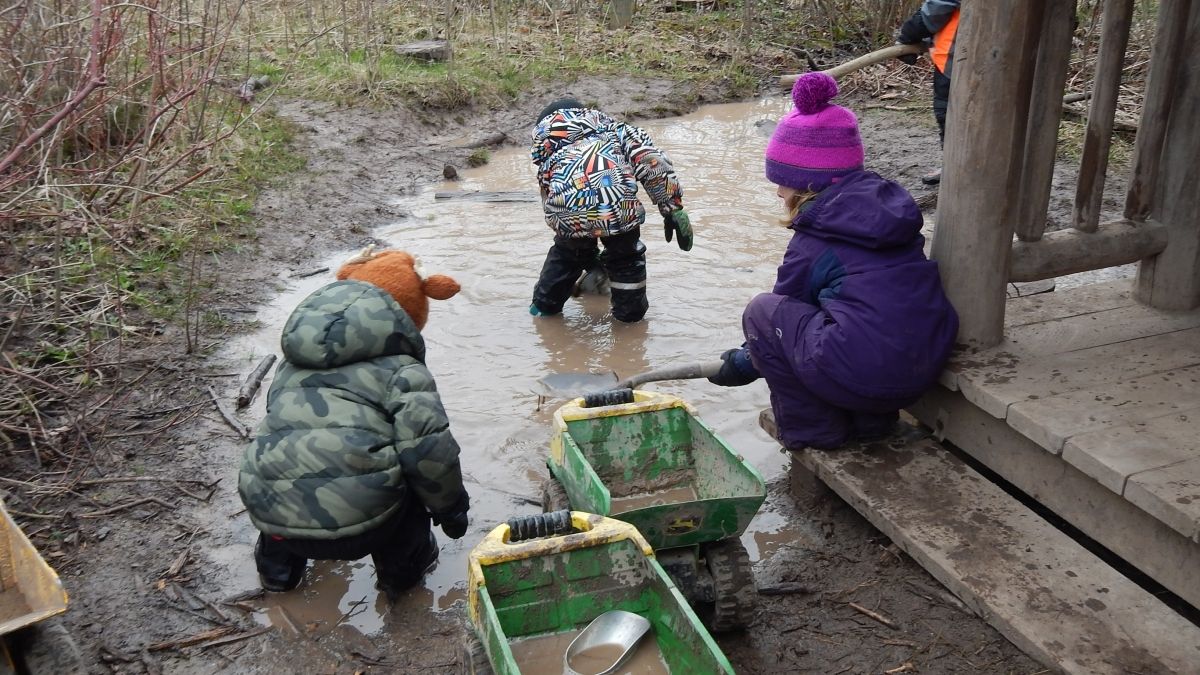
Schlitz Audubon Nature Center
This spring, the children were especially interested in building trenches in our sand area. So they would gather and discuss how they would like to create trenches for water flow. After gathering their tools, they would set out and start their work. Some would dig the trenches, others would collect the water from the mud pit in buckets and wheelbarrows. The children were engaged in digging long, winding trenches making islands in between, and bridges to go over the water. Dumping the water into the trenches would bring to life the moats and set the water to flow from one side to the other.
Sometimes there would be a disagreement about a trench and how it was soaking up too much water from other trenches. “We have to close that trench,” one said, pointing to a trench a child had been working on diligently. “No I like how it makes an island, I want to keep it.” A child who is a natural problem solver came over to try to mediate the situation. “The trench is soaking up a lot of water leaving this part too dry,” pointing to the dried up trench on the other side of the sand pit. “You can make another island, and we can help you.” “Alright,” agreed the child whose trench was soaking up too much of the water. “We can close it. Let’s make one over here.” With that, they set off making a new trench and closing the one that was interfering with their plans.
Lessons from the Earth
Mud, soil, earth, whatever you may call it, invites us to play, to feel and explore it. We get to play in mud however we want, with no set rules. There are endless opportunities to create or invent. Mud play is open-ended.
“Anyone want a meatball?,” a child asks as others are hard at work painting tree cookies with muddy water. I watch as she forms the mud into a ball in her hand, squeezing excess water out and placing it in a basket. Others around her are making cakes with the mud, dumping them on plates, putting them in a tree-cavity oven to bake and frosting them with muddy water. The children gather pine needles to decorate the cakes, asking whose birthday they’d like celebrate that day. Bringing their muddy creations to a sheltered spot to eat, to sing, and to enjoy each other’s company over muddy treats.
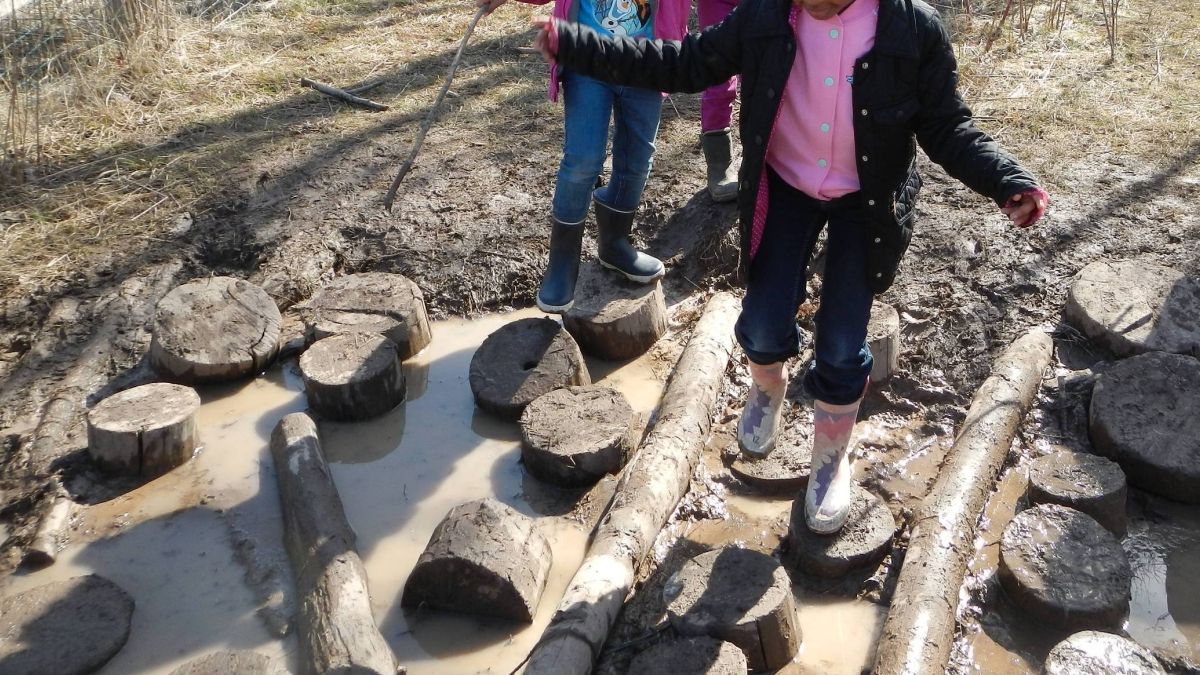
Schlitz Audubon Nature Center
During these formative years, mud play aids children in developing skills that are crucial developmental milestones. In our mud area, children sometimes roll tree cookies into the water as a way to cross the muddy water below as if it were lava. The children balance from one tree cookie to the next, taking time to decide their route. Sometimes a child will feel that another child is getting too close to them as they balance, and we teach them to tell the friend to give them space so they can continue. We encourage the children to use words to get their needs met, and support them when needed. The tree cookie lava game provides perfect opportunities for the children to hone their large motor skills, coordination and balance, and spacial skills, and it also often provides opportunities for them to build communication skills, too.
As the children play and explore mud, they are not only enjoying an intense sensory activity, but they are also learning lessons in how things work. They test theories, explore how gravity works, measure, and try new things. When the children were building their trenches, they started to realize that if they didn’t have someone continuously working on digging the trenches deeper, the water would soak into the sand leaving a dried area, which caused the water not to flow. So the children begin to make changes, learn from past experiences, and use words to express themselves.
Climbing Out
We are often asked how we deal with the mud that follows us indoors after playing and exploring it outdoors. We always say, “There’s never bad weather, only bad clothing.” Most days you will see us dressed in rain pants, coats, and boots for outdoor play. This allows us the freedom to play outside without the worry of getting our clothes dirty.
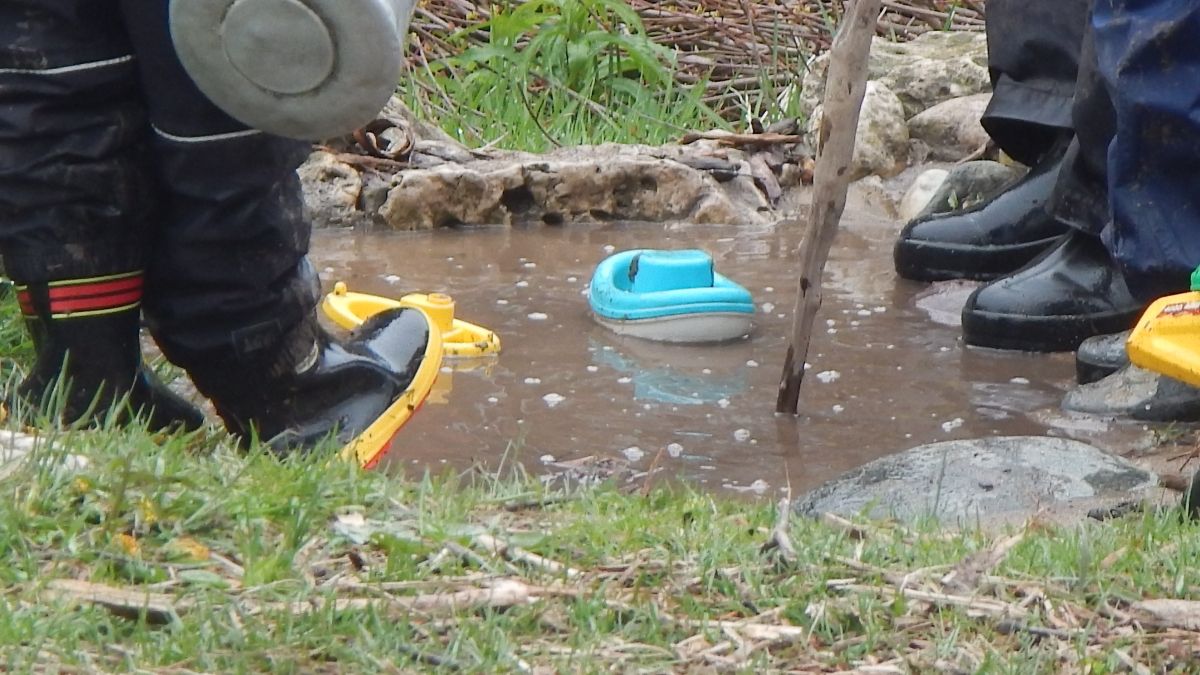
Schlitz Audubon Nature Center
Inside, we peel off our layers and hang our gear to dry. We have an indoor hallway with cubbies, but an outside area would also work. It’s funny that the children we see bathing in the mud will not want to touch their muddy gear. We remind them that we are washable and when we are done taking off our gear, we can wash our hands. Over time and with encouragement, the children practice and master taking off their own gear and hanging it up to dry.
Our parents bring reusable bags to place wet gear in to bring home at the end of each class. Some allow wet gear to dry before spraying it in the sink, or outside with a hose, while others just let the gear dry and bring it back for the next day’s adventure.
Embracing Mud Season
All seasons represent change and growth in the natural world. We may feel the change in the air as well as hear and smell these changes. The bitterness of autumn, the stillness of winter, the smell of new life in spring, and the long days of summer.
We teach our nature preschool students to embrace these changes and to explore each season to the fullest. We may start off the year being nervous to dip our boots in mud, but by the end we are sitting in it as if bathing in the muddy deliciousness. Take time to enjoy each season, but especially, dive into mud season.
About the Author
Jenn Leibham is a nature preschool teacher at Schlitz Audubon nature preschool in Milwaukee, WI. Her journey has led her to amazing people, inspiring places, and a deepening sense of self throughout it all. In August, she'll start a new adventure as a Lead Teacher at Tiny Trees Forest School in Seattle, Washington. In addition to teaching preschool, Jenn’s passion is to connect more with nature by working with the Children and Nature Network: Natural Leaders Network training young adults on how to connect their communities to nature.